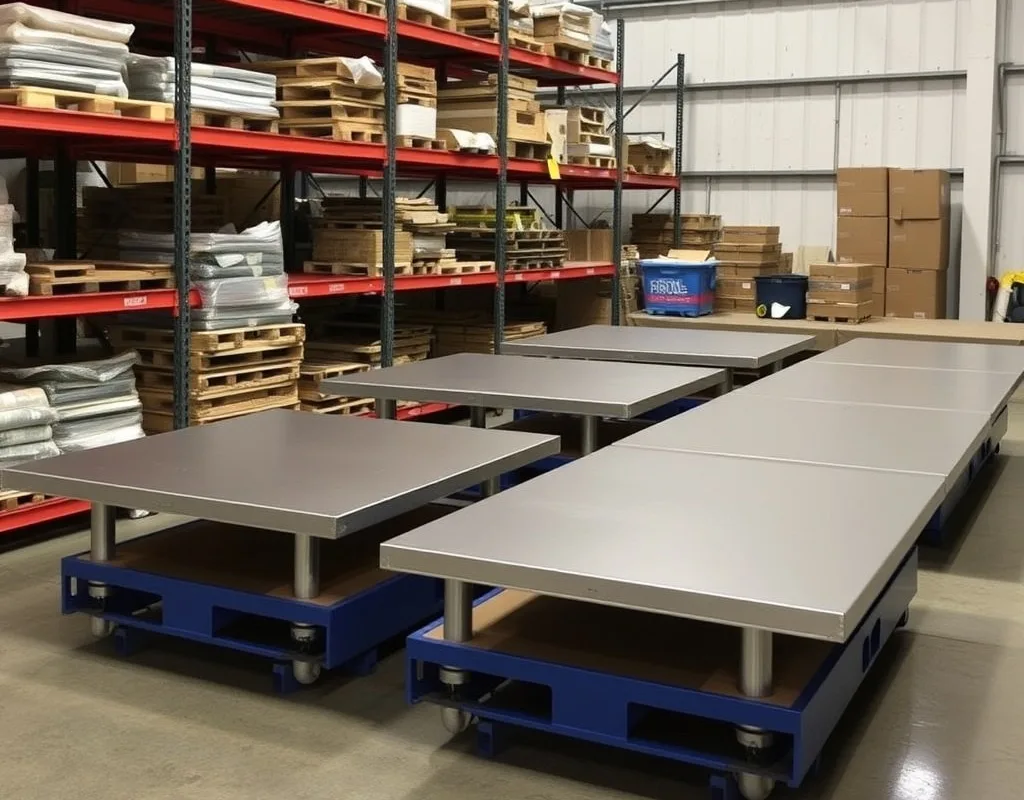Table of Contents Show
A loading table is a vital piece of equipment in industrial environments, serving as a stable platform for a wide scope of tasks such as assembly, inspection, and packaging. Its design plays a critical role in determining the efficiency and productivity of operations.
Loading table design is crucial for optimizing space utilization and functionality within industrial settings. Businesses can create loading tables that enhance workflow, improve ergonomics, and contribute to overall operational efficiency by carefully bearing in mind factors such as size, layout, features, and materials.
Space Optimization
In industrial environments, space is frequently at a premium. Efficiently designed loading tables can significantly improve workspace utilization. Consider the following factors:
- Size and Shape: The size and shape of the loading table should be tailored to the specific tasks and products it will accommodate. Custom-designed tables can often be more efficient than standard models.
- Layout: The layout of the loading table within the overall workspace is essential. Ensure it fits seamlessly into the workflow and doesn’t create bottlenecks or obstructions.
- Modular Design: Modular loading tables can be easily reconfigured to adapt to changing needs or accommodate different product sizes. This flexibility can enhance efficiency and reduce downtime.
- Adjustable Height: Adjustable height features can improve ergonomics and operator comfort, especially for tasks that involve repetitive lifting or reaching.
Functionality
A well-designed loading table should have the necessary features to support efficient operations. Consider the following:
- Work Surfaces: Ensure the work surfaces are durable, easy to clean, and provide adequate space for tasks.
- Storage: Incorporate storage solutions, such as drawers, shelves, or bins, to keep tools, materials, and finished products organized.
- Accessories: Consider accessories like casters, power outlets, and lighting to enhance functionality and operator convenience.
- Ergonomic Design: Prioritize ergonomic design to reduce fatigue and improve operator comfort. Factors such as table height, surface inclination, and tool placement are crucial.
Materials And Construction
The choice of materials and construction methods is essential for the durability and safety of loading tables. Consider the following:
- Materials: Select materials that are strong, durable, and resistant to corrosion, such as steel, aluminum, or high-density polyethylene (HDPE).
- Construction: Ensure the table has a sturdy frame and strong construction to withstand heavy loads and frequent use.
- Industrial Environments: For harsh industrial environments, choose materials and finishes that are resistant to chemicals, extreme temperatures, and moisture.
Safety And Compliance
Safety is paramount in industrial settings. Loading tables should be designed and constructed to comply with relevant safety standards and regulations. Consider the following:
- Safety Standards: Adhere to industry-specific safety standards, such as OSHA regulations in the United States or equivalent standards in other countries.
- Safety Features: Incorporate safety features like guardrails, non-slip surfaces, and emergency stop buttons to prevent accidents.
- Compliance: Ensure that the loading table complies with all applicable regulations, including those related to load capacity, stability, and electrical safety.
Cost-Effectiveness
While cost is a significant factor, it’s essential to balance cost with functionality, durability, and safety. Consider the following:
- Long-Term Costs: Investing in a high-quality loading table can result in long-term cost savings due to growth efficiency, reduced downtime, and extended lifespan.
- Customization: Custom-designed tables may have higher upfront costs but can offer significant benefits in terms of space utilization and functionality.
- Maintenance: Factor in maintenance costs when evaluating different options. Tables that are easy to clean and maintain can reduce long-term expenses.
By carefully bearing in mind these factors, you can design loading tables that optimize space utilization, enhance functionality, and improve overall productivity in your industrial setting.
Additional Considerations for Loading Table Design
While the previous sections have covered the essential aspects of loading table design, there are a few additional factors to consider:
- Casters: If the loading table needs to be moved frequently, consider adding casters for easy mobility.
- Locking mechanisms: Ensure the casters have locking mechanisms to prevent accidental movement when the table is stationary.
- Specific needs: Consider any unique requirements or preferences your organization may have.
- Tailored solutions: Work with a manufacturer or designer to create a loading table that perfectly suits your specific needs.
- Scalability: Design the loading table with future expansion in mind. This may involve modular components or extra space for additional equipment.
- Sustainable materials: Consider using sustainable materials and manufacturing processes to reduce your environmental footprint.
- Compatibility: Ensure the loading table is compatible with other equipment in your workspace, such as conveyors or storage systems.
Conclusion
A well-designed loading table can significantly improve efficiency and productivity in industrial settings. By carefully bearing in mind factors such as space optimization, functionality, materials, safety, and cost-effectiveness, you can create a loading table that meets your specific needs and contributes to the overall success of your operations.
Design The Perfect Loading Table for Your Industrial Needs
By carefully bearing in mind these factors, you can design loading tables that optimize space utilization, enhance functionality, and improve overall productivity in your industrial setting. To get started on designing the perfect loading table for your specific needs,
visit www.se.com and explore our wide range of loading table solutions and resources. Our team of experts can assist you create a customized solution that meets your unique requirements and budget.
FAQ:
A loading table serves as a stable platform for various tasks such as assembly, inspection, and packaging, playing a critical role in enhancing workflow and operational efficiency in industrial environments.
To optimize space utilization, consider customizing the size and shape of the loading table to fit specific tasks, ensuring the layout integrates seamlessly into the workflow, and opting for modular designs that can be reconfigured as needed.
A well-designed loading table should have durable work surfaces, adequate storage solutions, ergonomic design considerations, and useful accessories like casters, power outlets, and lighting to enhance operator convenience and efficiency.
It is best to select materials that are strong, durable, and resistant to corrosion, such as steel, aluminum, or high-density polyethylene (HDPE), particularly for harsh industrial environments.
Ensure that your loading table complies with relevant safety standards, incorporates safety features such as guardrails and non-slip surfaces, and is designed to meet load capacity and stability regulations to prevent accidents in the workplace.










